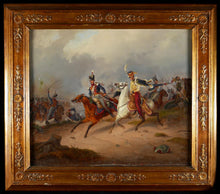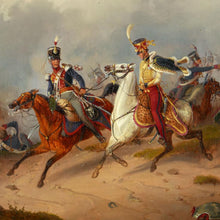2nd Light Dragoons, King's German Legion at Waterloo, 1815
Adding product to your cart
Overall: 46cm (19in) x 52cm (20.5in)
Oil on canvas over wood: 33.5cm (13.25in) x 39cm (15.25in). Signed and dated lower right ‘P. Hausser, Munich 1846’.
The present battle scene depicts the capture of a French Aide-de-Camp at the Battle of Waterloo by a Trumpeter Louis Zeitz of the 2nd Light Dragoons of the King’s German Legion. Identifiable from the crimson regimental facings, Roman numeral II on the shrabraque, and trumpet slung across the protagonist’s back, the scene is a direct visualisation of the act of gallantry cited by Trumpeter Zeitz’s commanding officer in 1819 for the award of the Guelphic Medal for Bravery.
‘Trumpeter Louis Zietz, 2nd Dragoons. In one of the charges made by his regiment at the battle of Waterloo, Zeitz noticed one of the enemy’s field officers retiring with their discomfited cavalry; he pursued him, attacked, and made him prisoner, and delivered him to Colonel Frederichs. The officer proved to be an aide-de-camp of Napoleon’s; his gold watch and well filled purse remained untouched in his possession, bearing honourable testimony to the disinterestedness of the trumpeter.’ (North Ludlow Beamish’s History of the K.G.L., vol. II, 1832-7).
Read More
The Guelphic Medal for bravery in battle was instituted by the Prince Regent in 1815 for non-commissioned officers and men of the K.G.L. and as such it is one of the first officially named gallantry medals. Although there were some blanket citations, most of the awards were for specific acts of gallantry such as Zietz’s. It carried with it a pension of 2 dollars a month. The identity of Zietz’s prisoner remains unknown. Napoleon’s personal staff comprised eight General Officer A.D.C.’s each of whom had two of three A.D.C.’s of their own to convey the multitude of orders issued at the height of battle. In addition to these there were twelve Officiers d’Ordnance or junior A.D.C.’s holding the rank of Capitaine.
The artist Philipp Hauser (1817-1873) is recorded as a painter of military and genre paintings, active in Mannheim and Munich in the mid nineteenth century.








